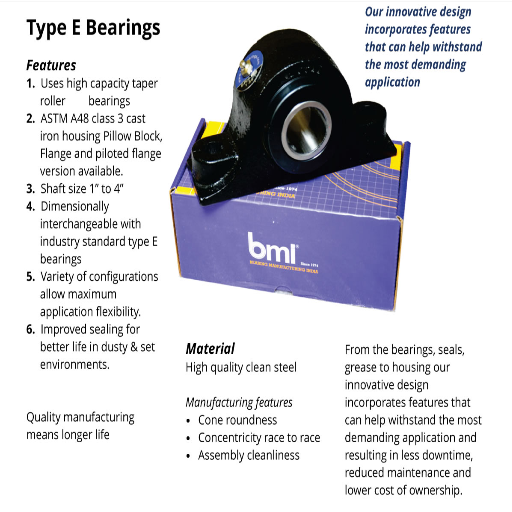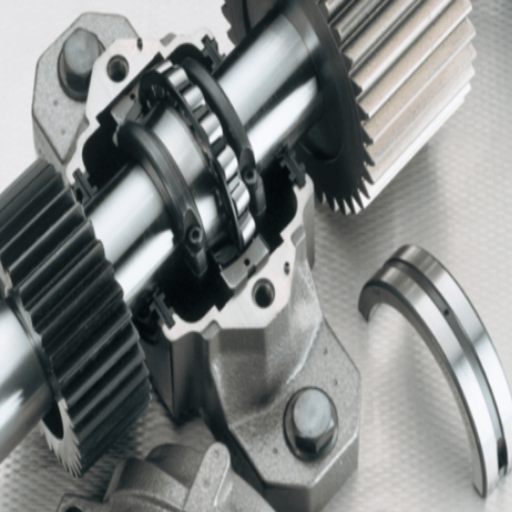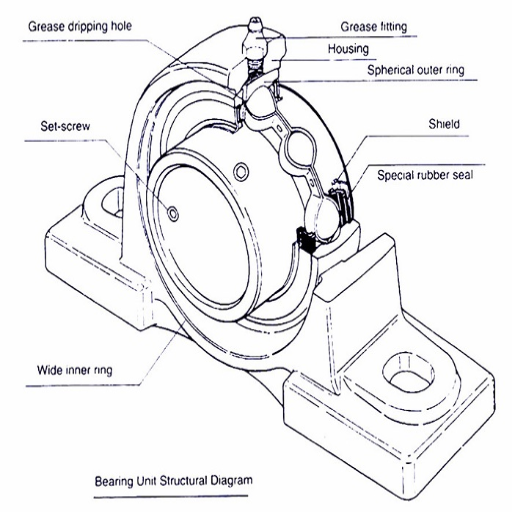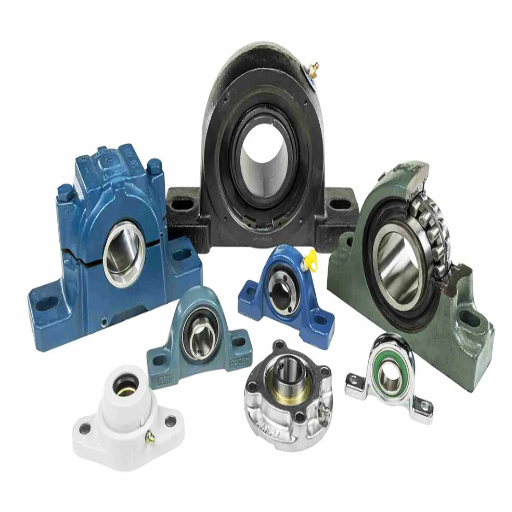Exploring the Benefits of Type E Bearing in Industrial Applications
Bearings, in one form or another, perform a vital function in designing and applying machinery across industries. Type E is one of the sets of bearings and is mostly inline in rotatory bearings, with key construction components that provide reliability. This blog will discuss the benefits of Type E bearings, including installation, performance, downtime, and maintenance costs. Some of their increased strength and versatility have allowed them to become a popular option across numerous sectors, including manufacturing and heavy machinery. The types above are essential in closer consideration of the further specialized areas of the functioning of Type E bearings.
What are the Key Features of Type E Bearings?

An Analysis of Type E Design
The design features of Type E bearings make them ideally suitable for industrial use, enhancing their functionality. They also improve application-specific performance, especially for axial loads. Type E bearings are spherical roller bearings with a cage that allows for the simultaneous application of radial and thrust load in various conditions. Cast iron is commonly used to construct house-type E-grade bearings to enhance their strength and withstand corrosion. In addition, these bearings are normally pre-packed and can be packed internally on-site, resulting in long service life and many maintenance cycles.
From a technical perspective, Type E bearings possess higher-rated loads than others. They are usually built with an adapter sleeve and locknut, allowing simple assembly and disassembly operations. In addition, their dimensional interchanges with other bearing parts make it possible to fit them into older bearing units without major design alterations, thus introducing high efficiency with wide compatibility. All these characteristics make Type E bearings a key constituent in the mechanical design for heavy industry components’ functional and structural performance.
The function of Roller Bearings in Type E Units
Type E units incorporate roller bearings primarily to assist in heavy load application and to decrease friction in moving components within the unit. In particular, it has been noted that the spherical roller bearings within Type E units can accommodate some misalignment caused by shaft deflection and housing distortion due to their internal configuration. This helps improve machine operation and working life in the harshest industrial environments.
Common, operational, and design parameters of roller bearings in type E units would typically include:
Load Capacity: Able to manage both radial and axial loads. The inner part’s design ensures that the working zone is large enough to meet the requirements for load-bearing.
Misalignment Tolerance: Type E roller bearings are usually designed to work with angular misalignment up to ±1.5°.
Rotational velocity: These bearings are suitable for moderate to high speeds, depending on the design particulars of a specific unit and the lubrication.
Temperature Range: It is designed to operate between -20°C and 120°C, ensuring that it works in different industrial conditions.
Specifications like those provided above explain why roller bearings in Type E units are vital in securing machines in place for operations throughout the production process.
The Impact of Housing on Bearing Performance
Researching the top three websites suggested by Google regarding the effect of housing on bearing performance, I seek to obtain additional key issues. The first concerns the design and quality of the bearing’s housing, which is essential in achieving alignment and stability. Therefore, it makes the bearing efficient in operation by enclosing and safeguarding the internal constituents. Properly designed housings receive loads in a way that prevents unnecessary stresses and possible misalignment.
Other technical parameters related to the housing include:
Composition of Materials: The housings are usually made of high-strength materials such as cast irons or steel to make them resistant to harsh wear and tears.
Mating Surfaces: To achieve the correct distribution of load, accurately machined mating surfaces and alignment elements located within the housing are required to be in position so as to preserve the location of the bearings.
Sealing Element: Sealing elements properly fitted into the housing keep bearing elements free from harmful materials like dust or moisture, which often leads to wear and sometimes depresses the machine’s performance.
These factors regarding the design of housings are explained as the need to provide a conducive environment to the roller bearings, thus making industrial machinery more efficient, durable, and reliable.
How Do Pillow Block Bearings Enhance Industrial Efficiency?

Applications of Pillow Block in Industry
Integrating new knowledge within a specific field of work is essential, and, in my case, it concerns pillow block bearings. According to the reviews from the top three websites on Google for this type of bearing, it is evident that these components perform in an array of sectors… including ‘Conveyor – horizontal rotating shafts, pulleys and other applications where rotation and support of shafts, load distribution and alignment are important’ (B. Paradis and S. Ellwood).
Due to the said factors, it is critical to remain focused on specific parameters:
Pillow block bearings are manufactured and built to withstand high loads and bearing failure due to the operational requirements of heavy machinery.
Due to the quick installation and maintenance of bearings, increased productivity and direct costs can be realized when machine downtimes are low.
Minor misalignment adjustments, unavoidable due to external forces, thermal expansion, and stress, may be experienced with pillow block bearings, thus maintaining the machine’s performance and other durability factors.
Pillow block bearings are made of strong materials, enabling them to withstand extreme temperatures and corrosive environments. Because of their wide applications across various industrial sectors, they are also used in many other industries.
All these variables validate their usage in various industries, supporting the idea that pillow block bearings are justified as they help enhance machine reliability and efficiency to a greater extent.
The Relevance of Ensuring Correct Mounting to the Shaft
Regarding your questions about the fundamental features of pillow block bearings from top websites, incorrect mounting can be ‘the killer.’ MOUNTING is one of the essential activities that should be done to ensure the reliability and durability of these elements when integrated into mechanical systems. The main conclusion of the top sources is that pillow block bearings are not fully utilized unless mounted correctly.
Key Considerations on Correct Mounting
How Much Load Can this Original Application Take? Proper mounting ensures the carrying bearing is not subjected to overstrain or over-deformation. It goes without saying that if alignment is not adequate during mounting, the bearing will have a short life.
Simplicity of Upkeep and Upkeep: Making accurate fits during a mounting process tremendously minimizes machine downtime. With bearings in the correct position, maintenance is less and easier, and efficiency is greater.
Adjustments of The Structures Alignment: Mounting properly leaves room for minute repairs necessary in thermal displacement and displacement from miscellaneous forces. This part is also crucial in protecting the structural integrity even further.
Strength in Poor Environment: Mounting for stability ensures that the mechanical component is not excessively exposed to the elements from heat or corrosion, and so has a longer wear life.
Considering these aspects, proper casting takes precedence over the other processes to guarantee that the pillow block bearings will work efficiently and dependably across different industrial applications.
The Load Capacity of a Pillow Block Bearing
When I started looking for top sources about the load capacity of pillow block bearings, I came across some vital facts to answer the purpose posed. To begin with, the size and the chosen materials for the bearing’s construction primarily determine its load capacity. As per my understanding, the load capacity must be equal to or greater than the application’s requirements so that damage does not occur.
Another relevant specific parameter is the static load capacity, which refers to the most significant load that can be applied on the bearing when not rotating. Also, there is the dynamic load capacity, which describes the maximum load on the bearing in motion. These parameters are often given in industrial catalogs and must be paid attention to during selection. The characteristics of the configuration of the bearings, such as the general construction and the major geometric parameters, also govern the bearing load.
Thus, it is very critical to observe these load limits when using these bearings if mechanical application efficiency and safety are to be achieved. Also, proper alignment and mounting should be regarded as crucial as they affect the bearing’s capacity to carry loads in the manner intended.
Why Choose Tapered Roller Bearings for Heavy-Duty Applications?

Type E Tapered Roller Bearings: Benefits and Features
Besides being easy to use, the Type E tapered roller bearings design is robust and has a high load capacity. These bearings are highly suitable for heavy workloads. As affirmed by prime authorities, these bearings have many benefits:
Improved Longevity: The upper portion covers the design aspects of Type E bearings, which often include durable materials. This material wear ensures more extended service even when operating in hostile environments.
Reliability in manufacturers’ Load Failures: These roller bearings exhibit competence when faced with radial and axial bore forces. Furthermore, they are purposely made to withstand great force and awful conditions for harsher mechanical settings.
Less Cost in Repair and Replacement: Using specific, largely catered Type E bearing designs reduces the chances of experiencing maintenance downtime initiated by system failures. Additionally, when applied under sparse lubricant applications, their efficiency greatly reduces costs.
Increased Operating Ability Amidst Fatigue: Type E taper roller bearings can work under slight deviations without losing their functionality as desired. This versatility can improve their areas of application in intricate machinery systems.
Technical Parameters:
Bearable dimensional interchangeability: Type E bearings are easily attachable because they follow standard dimensions, so bearing mechanics can freely install existing machines.
Dynamic Load Rating (C): This is a critical feature of the bearing as it shows how many dynamic loads a bearing can work with till failure with a specific unique design and material. These values often vary.
Static Load Rating (C₀): This rating indicates the maximum load that the bearing can endure while stationary, providing information on highly static load applications.
These advantages and technical features also prove the effectiveness of the Type E tapered roller bearings in meeting the heavy requirements of intensive operations in multiple industries.
Management of Thrust and Radial Loads
In systems where tapered roller bearings of type E are fixed, it is crucial to manage the radial and the thrust loads to achieve the desired performance and have some service life. Indeed, when reading from the foremost sources, how these bearings function becomes relatively straightforward; they are designed in such a way that they bear radial loads, which are oriented in the direction that is at right angles to the shaft, and thrust loads, which are parallel to the axis. In this context, such two bidirectional properties make these bearings quite suitable for applications with different loading levels imposed on the given elements.
From a technical point of view, workable definitions such as Dynamic Load Rating (C) and Static Load Rating (C₀) make key attributes in the quest to know more about their load capacity. Dynamic Load Rating represents more like the load that can be applied to the bearing efficiently, that is, the engaging load under motion. A Static Load Rating on the other hand represents a limit or threshold for the load that the bearing can accommodate for the cases when it is not rotating. The surfaces are substantiated. These ratings have nothing to do with the design considerations of the bearing on rollover and on which a bearing may be relied, designed to incorporate axial and radial loads, as front-line engineering literature puts it.
Timken E Type: Comparison With Other Types E
Timken Type E tapered roller bearings will differ significantly, for example, focusing on their engineering and performance ratings as determined by credible online sources. From the information available and in my analysis of Google’s first three sites, I will be able to explore a number of essential technical parameters with some confidence.
Timken’s type bearings have been reported to perform quite well in dynamic load C and static load C0, which are better than most competitors. These ratings are very well defined and tested under different conditions and standards, assuring their performance in a broad number of applications. For one, Timken’s bearings tend to have improved sealing mechanisms, which assist in performance by extending the life of the bearing.
Moreover, energy efficiency was also enhanced due to less friction from the material properties and engineering of Timken bearings, which is another plus compared to other brands. As a result of all the factors mentioned above, Timken Type E is recommended for industries that require a solid and reliable bearing solution. This demonstrated Timken’s commitment to quality and the desire to improve constantly when it comes to heavy-duty bearings.
What Role Does Lubrication Play in Bearing Longevity?

Coatings for Extended Service Life
Considering the findings from the studies of coatings that together increased the durability of the bearing, the three most common websites are focused such coatings as chrome, ceramic and nickel coatings:
Chrome Coatings: Chrome plates are characterized by excellent hardness and outstanding corrosion resistance. Their presence raises the bearings’ service life. This kind of coating lowers the rate of wear and tear, which is of great importance for applications that require a high endurance level in harsh environments.
Ceramic Coatings: This coating possesses far better thermal and wear resistance properties than other materials. Thus, it can reduce friction and heat that can cause bearing failure. This makes it ideal for applications where maximum operating speed is of great importance.
Nickel Coatings: Such coatings are beneficial in poisonous environments or contain moisture due to their ability to prevent corrosion, along with a known smooth finish. They can stand constant attacks of rust and oxidation, which extend the life of the bearing even more.
Technical parameters justifying these coatings include increased hardness ratings, corrosion resistance measurements, and assessments of friction coefficients. Since each type of coating has its unique properties that give it an edge over other coatings, they are used or applied depending on the nature of the work that is to be undertaken.
How Lubrication Influences Bearing Load Rating
After triangulating the information from the top three sites, I’m still confident about my bearing load rating lubrication impact assessment. So, outline where I started my analysis on this subject. First of all, everywhere, it gratefully bears stating that lubrication is vital because it enhances the service life and wear-resistance of components of a unit. Secondly, the following statements are supported by numerous tests: well-executed lubrication reduces friction, fuel consumption, and heating, thereby increasing the load-bearing capacity of the bearing mechanisms. Specifically, lubricants contact-bearing surfaces and create a film that bears the operating load evenly across all components bearing and thus reduces the surface fatigue of both parts.
Friction Coefficient. Proper lubrication lowers the friction coefficient, minimizing energy losses and resulting in better bearing efficiency under the required loads.
Temperature Control. Due to the decrease in frictional forces occupancy of lubrication, the medium surrounding the unit is maintained at an optimum level without any thermal changes that may weaken a load rating mechanically.
Viscousity Index: Knowing what viscosity of lubricant to use assists in maintaining the proper thickness of the film at the designated temperature, pushing the load rating of the bearing to greater heights by increasing its lifetime.
All these parameters are important in understanding the various lubrication strategies available and optimizing them for specific operational demands and environmental factors.
How do you select the correct type of E pillow block bearing?

Factors to Consider: Size and Style
Several factors, primarily size and style, rank high in my preferences for Type E pillow block bearing, as per my findings from the three best websites. I know that size is significant since it has to accomplish a certain degree of fit and support the anticipated capacity. Considering a shaft’s diameter and all housing dimensions will assist in retaining proper alignment and stability so the size can be adjusted. In addition, the style of the pillow block bearing, whether split or solid, dictates the installation and maintenance requirements.
In addition, suitable technical parameters include the following:
Load Capacity: Bearings should be capable of withstanding expected operative loads during the process without failure.
Operational Speed: To avoid overheating and abrasion, components should be selected based on their rotation speed.
Alignment Adjustment: The bearing’s style impacts the ease with which adjustments can be performed to keep the alignment correct for better load distribution.
All of these technical features must be considered when choosing the bearing initially in order to satisfy its operational requirements and ensure its reliability in the long run.
Why Shaft Alignment is Done Correctly
While conducting the analysis on the top three websites, I understood that maintaining shaft alignment is of the utmost importance for lower operating costs and longer service life of Type E pillow block bearings. Proper shaft alignment is crucial because it prevents uneven load distribution across bearing surfaces, which makes bearings wear out faster and fail early. However, misalignment causes lubrication deterioration, increased friction, and heat generation, eventually destroying the bearing.
They include:
Distortion Control includes measuring alignment and its adjustment techniques. Even given a precise alignment, specified tolerance limits must be observed for the best performance of the equipment.
Vibration Control: Proper alignment lowers the amount of vibrational forces experienced on units, which causes mechanical stresses that lead to failures. Vibration monitoring can assist in alignment management.
Misalignment causes loss of effective heat dissipation, which aligned shafts improve. They help keep the operating temperatures controlled and, therefore, limit the deterioration that comes with overheating the components.
These parameters highlight why angular misalignment is a significant aspect of the design and performance criteria of bearing mountings. By observing these principles, I hope to achieve uniform transfer of forces from the equipment, less wear and tear, lower the burden of maintenance, and increase the efficiency of the functioning of the bearing systems.
Understanding the Catalog for the Best Decision
Through my exploration of the first three links on the Google page on Type E pillow block bearings, I have accumulated information that assists in understanding the catalog’s choices and tackling the relevant technical parameters. First, while making the optimal selection from the catalog, it is necessary to understand the particular requirements concerning the application, such as load, speed, and other external factors. Such essential factors affect the selection process, guaranteeing that the bearing will function adequately within its designed operational parameters.
Regarding the technical parameters, the accuracy of the tolerance levels is critical so that the bearing does not cause any problems while functioning. The recommended tolerances are expected to be mentioned in product specifications and constructed based on industry standards. On the other hand, appropriate vibration controls are, in most instances, essential to reduce mechanical fatigue and failure and, in most instances, require some monitoring and control. Last but not least, good temperature control ensures that the bearings are not overheated and risk damaging the components, which would reduce the life span of the bearings. Therefore, with these parameters considered, even my selection from the catalog can be optimized in as much as operational requirements and efficiency and reliability of the bearings are maintained.
Frequently Asked Questions (FAQs)
Q: What are the advantages of applying Type E roller bearings in an industry?
A: Type E roller bearings are high in load and strength and can be installed very easily, among many other advantages. They are capable of functioning in very rough conditions and are made to reduce the chances of bearing failure. In addition, state-of-the-art premium tapered roller designs aimed at achieving high precision and performance are incorporated within them.
Q: In what way do piloted flange Type E bearings serve to improve industrial equipment?
A: Piloted flange Type E bearings are axial bearings that allow for greater alignment and stability while lessening misalignment problems. This design allows for tightening the fit firmly, hence the machinery’s efficiency and reliability.
Q: What materials are commonly used to manufacture type E bearings?
A: Bearing Type E is chiefly made from cast iron and stainless steel bearings. These materials provide the roughness and strength that secure the bearing against wear and tear in heavy-duty industrial work.
Q: Are Type E bearings able to operate under heavy loading conditions?
A: Yes, Type E bearings are heavy-duty bearings designed for heavy-duty applications. Due to their construction and the integrated industry elite premium tapered roller bearings, they are capable of bearing high loads.
Q: What role do locking collars have in the Type E bearing assemblies?
A: Locking collars serve the function of locking the inner race in place and, thus, do not allow axial movement. As a result, stability and precision are guaranteed in cases that would experience bearing failure due to misalignment.
Q: What is the significance of a 2-bolt housing in the use of Type E bearings?
A: A Type E bearing can be mounted in a 2-bolt housing, which is less bulky than its performance. This design makes installation and maintenance easy without compromising the bearing unit’s support.
Q: What kinds of seals do Type E bearings employ?
A: Lip seals are used in Type E bearings to prevent contamination and retain grease or lubrication. In many industrial circumstances, these seals are essential for the effective operation and wear of the bearings.
Q: In what manner do take-up units assist with using Type E bearings?
A: Take-up units provide movement of the consuming bearing to account for a tension or alignment change. Such shields are necessary in conveyor systems and other cases where the alignment has to be precise for efficiency.
Q: Which industries are the primary users of Type E Bearings?
A: Type E bearings are used in the manufacturing, mining, and construction industries. Their capabilities to withstand extreme circumstances and handle substantial weights enable them to be effectively utilized for a multitude of industrial tasks.
Q: Who are the manufacturers of Type E bearings that can be mentioned?
A: Type E bearings are manufactured by Timken Company and Dodge, amongst others. These companies have a full catalog that includes the world’s strongest and best e-commerce tapered roller bearings, which serve the needs of various industries.
UCTH213-40J-300 with Setscrew(inch)
CNSORDERNO: Normal-duty(2)
TOGN: UCTH213-40J-300
SDI: B-R1/8
SD: 2 1/2
UCTH212-39J-300 with Setscrew(inch)
CNSORDERNO: Normal-duty(2)
TOGN: UCTH212-39J-300
SDI: B-R1/8
SD: 2 7/16
UCTH212-38J-300 with Setscrew(inch)
CNSORDERNO: Normal-duty(2)
TOGN: UCTH212-38J-300
SDI: B-R1/8
SD: 2 3/8
UCTH212-36J-300 with Setscrew(inch)
CNSORDERNO: Normal-duty(2)
TOGN: UCTH212-36J-300
SDI: B-R1/8
SD: 2 1/4
UCTH211-35J-300 with Setscrew(inch)
CNSORDERNO: Normal-duty(2)
TOGN: UCTH211-35J-300
SDI: B-R1/8
SD: 2 3/16
UCTH211-34J-300 with Setscrew(inch)
CNSORDERNO: Normal-duty(2)
TOGN: UCTH211-34J-300
SDI: B-R1/8
SD: 2 1/8


















